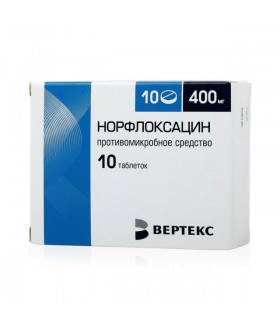




Security policy (edit with Customer reassurance module)

Delivery policy (edit with Customer reassurance module)

Return policy (edit with Customer reassurance module)
Instructions for use Active ingredients Norfloxacin Release form Tablets Composition Norfloxacin 400 mg Excipients: microcrystalline cellulose - 143 mg, croscarmellose sodium - 36 mg, povidone - 12 mg, colloidal silicon dioxide - 3 mg, magnesium stearate - 6 mg. The composition of the film shell: hypromellose 9 mg, hyprolose - 3.49 mg, talc - 3.47 mg, titanium dioxide - 1.956 mg, iron oxide yellow - 0.084 mg. Pharmacological effect Antimicrobial synthetic agent of the group of fluoroquinolones with a broad spectrum of action. Has a bactericidal effect. By suppressing DNA gyrase, it disrupts the process of DNA supercoiling. Highly active against most gram-negative bacteria: Escherichia coli, Salmonella spp., Shigella spp., Proteus spp., Morganella morganii, Klebsiella spp. (including Klebsiella pneumoniae), Enterobacter spp., Serratia spp., Citrobacter spp., Yersinia spp., Providencia spp., Haemophilus influenzae, Pseudomonas aeruginosa, Neisseria gonorrhoeae, Neisseria meningitidis. Active against some gram-positive bacteria (including Staphylococcus aureus). Anaerobic bacteria are resistant to norfloxacin, Enterococcus spp. Are insensitive. and Acinetobacter spp. Resistant to the action of β-lactamases. Pharmacokinetics When taken orally, about 30-40% is absorbed, food intake reduces the rate of absorption. Plasma protein binding is 14%. Norfloxacin is well distributed in the tissues of the urogenital system. Penetrates the placental barrier. About 30% is excreted in the urine unchanged. Indications Infectious and inflammatory diseases caused by microorganisms sensitive to norfloxacin. For oral administration: diseases of the urinary tract, prostate, gastrointestinal tract, gonorrhea, prevention of recurrence of urinary tract infections, bacterial infections in patients with granulocytopenia, travelers' diarrhea. For topical use: conjunctivitis, keratitis, keratoconjunctivitis, corneal ulcers, blepharitis, blepharoconjunctivitis, acute inflammation of the meibomian glands and dacryocystitis, prevention of eye infections after removal of a foreign body from the cornea or conjunctiva, before and after injury after surgery; otitis externa, acute otitis media, chronic otitis media, prevention of infectious complications during surgery on the organ of hearing. Contraindications Pregnancy, lactation (breastfeeding), childhood and adolescence (up to 15 years), deficiency of glucose-6-phosphate dehydrogenase, hypersensitivity to norfloxacin and other quinolone drugs. Application during pregnancy and lactation Norfloxacin is contraindicated during pregnancy and lactation (breastfeeding), since it has been established in experimental studies that it causes arthropathy. Method of administration and dosage Individual. A single dose for oral administration is 400-800 mg, the frequency of use is 1-2 times / day. The duration of treatment is determined individually. In ophthalmology and ENT practice, it is used topically. Side effects From the digestive system: nausea, heartburn, anorexia, diarrhea, abdominal pain. From the side of the central nervous system: headache, dizziness, fatigue, sleep disorders, irritability, anxiety. Allergic reactions: skin rash, itching, Quincke's edema. Co side of the urinary system: interstitial nephritis. Interaction with other drugs With the simultaneous use of norfloxacin with warfarin, the anticoagulant effect of the latter is enhanced. With the simultaneous use of norfloxacin with cyclosporine, an increase in the concentration of the latter in blood plasma is noted. With the simultaneous administration of norfloxacin and antacids or preparations containing iron, zinc, magnesium, calcium or sucralfate, the absorption of norfloxacin is reduced due to the formation of complexones with metal ions (the interval between taking them should be at least 4 hours). With simultaneous administration of norfloxacin reduces the clearance of theophylline by 25%, therefore, with simultaneous use, the dose of theophylline should be reduced. The simultaneous administration of norfloxacin with drugs that have the potential to lower blood pressure can cause a sharp decrease in blood pressure. In this regard, in such cases, as well as with the simultaneous administration of barbiturates, anesthetics, heart rate, blood pressure, and ECG indicators should be monitored. Simultaneous use with drugs that lower the epileptic threshold can lead to the development of epileptiform seizures. Reduces the effect of nitrofurans. special instructions It should be used with caution in patients with epilepsy, convulsive syndrome of another etiology, with severe renal and hepatic impairment. During the period of treatment, patients should receive a sufficient amount of fluid (under the control of diuresis). Norfloxacin should be taken at least 2 hours before or 2 hours after taking antacids or preparations containing iron, zinc, magnesium, calcium, or sucralfate. Prescription